GJ: Now , if you look at this picture..
JW: Thank you. This is a good example. It's going straight up. Imagine that.
GJ: That was smoke that was there before the collapse.
JW: What, down here on the fiftieth floor? The fortieth floor? I thought the fire was up at the eightieth floor.
GJ: I know all that dust... that picture right there... that dust was there before the collapse, because that's the smoke coming from the fire.
JW: But this (points to Banker's Trust building) is a forty-story building, so this is emanating from the fiftieth floor.
GJ: What's emanating form the fiftieth floor?
JW: The stuff that's going up.
GJ: How do you know the stuff emanating from the fiftieth floor is going up?
JW: It's not going down.
GJ: There's stuff going down in that picture, that's my whole point.
JW: You've just gone around the circle. You're saying it was there before the tower went 'pouf?' But the tower is in good condition up to about the seventieth floor or whatever it was.
GJ: It wasn't that high.
JW: I didn't see the fire down here.
GJ: Could we go back to the original point? I mean...
JW: But this is what what you're asking about here.
GJ: I'm asking about the radius the debris falls on the ground.
JW: Wait a minute! Because this wasn't working for you, you wanted to change to another subject?
GJ: No.
JW: We'll stay with this one. Here the dust is going straight up. Well, that's where we came from because you were saying the dust all went straight down, and I'm saying the dust goes up, and I'm using this picture to emphasize that it goes up. Here's about where the fiftieth floor would be. If that's a forty-storey building, the fiftieth floor is just about there, and it looks like all the stuff coming up is coming from there.
GW: (No reply)
JW: So where's the rest of the building?
GJ: Well, I ... I don't know.
JW: Oh , wait a minute , You're saying it it burned up, in four seconds? Five seconds?
GJ: I didn't say the building burned up. I said there was smoke from the fires that went up.
JW: But if there were some fires, fires were up here (indicates). This was fifty stories, so where would that make 110 stories, like up here? (indicates )
GJ: It wouldn't be that high, no.
JW: Well, we don't see the bottom of the building.
GJ: But you know roughly what the width of the building was, that ratio.
JW: It's somewhere up here.
GJ: The width of the building is 200 meters and the height is like 1300 meters[sic].
JW: 1368. And we don't see the bottom here. The bottom's down there somewhere.
So, if this is a forty story building here, we don't see the bottom of the building. It's probably about that big. We're now up to the eightieth floor, so it's going to be about somewhere in there.
GJ: OK.
JW: So if you have something up here - and that's where the fire was - why is the smoke coming from down here?
GJ: I don't know why it is coming from down there.
JW: What about this part of the building ( points to top )?
GJ: From that picture it looks like a lot of it goes down.
JW: Where's it going down?
GJ: You don't see any parts of the building going down there?
JW: I see that we have about one third of the building left. Two thirds of the building is missing, and it's not in the volume of this 'snowball' as I call it, to account for two thirds of the building.
GJ: So- what's going down? Is there any debris falling?
JW: I don't see anything that's really falling there.
GJ: You don't see any debris falling from the building?
JW: I see a round snowball. I call this a snowball.
GJ: Okay, so there' s no debris falling in that picture.
JW: I didn't say no debris.
GJ: How much debris? What debris is falling in that picture?
JW: I see some... I don't have a magnifying glass. Sorry!
GJ: Oh, it's that small you can't tell what's falling from the picture?
JW: Below this point here ( points to bottom of the snowball). I don't se much difference. It look like the building is in good health. There's a little bit of cloud of haze there, but... I don't see any major material and the building is still completely intact from this point down, at that moment, below the snowball.
GJ: So you really don't see any falling debris there?
JW: Are you asking these questions for sincere, honest purposes?
GJ: I really am. This is sincere. I see falling debris in that picture and I'm wondering, I can't fathom why you don't see falling debris in that picture. It's hard for me to understand.
JW: Maybe ...
GJ: Because maybe I don't understand what you're trying to say.
JW: I'm not saying there is absolutely no debris, because someone may have had some, like, pennies on their windowsill that fell out. They might be falling down. But it's not a significant volume of material.
GJ: I see. OK.
JW: the snowball here is about... it's bigger than the width of the building, and about that same amount in height. So, it's a little bit wider so you can't say it's the density of the building.
GJ: No, you can't say it's the density of the building.
JW: It's less dense, so we're missing two thirds of the building already...
GJ: Yes.
JW: ...where did it go?
GJ: I don't know. I saw it go down, but maybe I don't remember seeing the videos right or something.
JW: I don't see it below that point.
GJ: That's because this is a picture shot before the whole building collapsed. It's during the collapse.
JW: "Collapse?" If it was a collapse I would expect to see the material piled up. If it was literally a collapse, this is about two thirds of the building. How compact might that be...
GJ: Remember the ratio of the building is 200 meters wide by 130 meters tall[sic!]. OK.
JW: Correct. But you have this perspective of depth in the picture. I'm just going by this is a 40 story building, and its bottom is below the picture. That's 40 stories, that's 40 stories, that's 40 stories, so 110 is up to here. So between here and here you have a whole lot of building to account for. And it' s 207 or 208 feet wide all the way up to that point, but it's still two-thirds of the height.
GJ: The width is two thirds of the height?
JW: No. The amount that's missing is two thirds of the height.
GJ: OK . All right.
JW: It's missing , and this snowball can't account for it all. Where'd it go?
GJ: Well, I'm not sure if that's...I mean, I'm not sure if that accounts for it all. I saw a lot of debris go down from that building, and based on that picture it seems plausible to me that most of the building is within that debris.
Comment from audience: (inaudible)the pyroclastic flow that happened.
JW: It hasn't got down to any point to flow anywhere yet.. It's just...this material here is all that's left, except for what's going up.
Audience member: So is the pyroclastic flow included in the debris moving out?
JW: I wouldn't really call this a pyroclastic flow. I would call this explosions. This part of the building is being exploded out.
Audience member: You were both disagreeing on the amount of debris, how far it went away. I just wondered if you include that in the debris (inaudible)...
JW: I'm just saying, there's not much building left. I'm not saying exactly what radius it goes to. You have inch deep dust a mile or two away. Do you count that? It gets spread all over the place. But what I see in this picture is we don't have much building left, and it has yet to hit the ground.
GJ: OK. (searches through papers) Um...
JW: I'm glad you brought this. This is my favourite picture.
GJ: Excellent. I'm glad. Well, I guess that accounts for why you put it on your website. OK. All right. So, for any kind of beam weapon to annihilate the steel or anything like that, you would have to pump in a certain amount of energy to do that.
JW: It depends what wavelength you use.
GJ: No. The energy doesn't depend on the wavelength.
JW: It does to the extent of how efficient that energy is with that material.
GJ: OK . All right, so if you pump in a laser to heat the building up...
JW: Think how much energy it takes to heat a cup of coffee in my microwave, versus that same water on the stove. Different amounts of energy...
GJ: True. That's because we know that the microwave is exciting the resonant energy of the water to heat your coffee.
JW: The heat is exciting the water too,
GJ: Right, but it still takes the same amount of energy to heat that coffee no matter how much energy you lose.
JW: But it's a lot less efficient.
GJ: Okay. If you assume that you don't lose any energy at all, okay, and you vaporize steel, you can calculate what energy is involved in vaporizing steel. It doesn't matter how you do it.
JW: Yes, it does.
GJ: No, that would only increase the number.
JW: How about if you heat the water up by putting a resistance across it versus putting a fire next to it?
GJ: The minimum amount of energy to evaporate a wire, by fire, by electric current, by anything...
JW: We're not talking about evaporation. This is like, kind of, being silly. You started out talking about dustification, then you're talking about beam energy, then native (?) energy, then it's about vaporization...
GJ: This is not me, this is from your website. It's you saying these things.
JW: I'm taking about the data on my website. I'm not making calculations for how much you took for anything, as I don't think we should get distracted with that...
GJ: Conservation of energy is not a distraction.

















